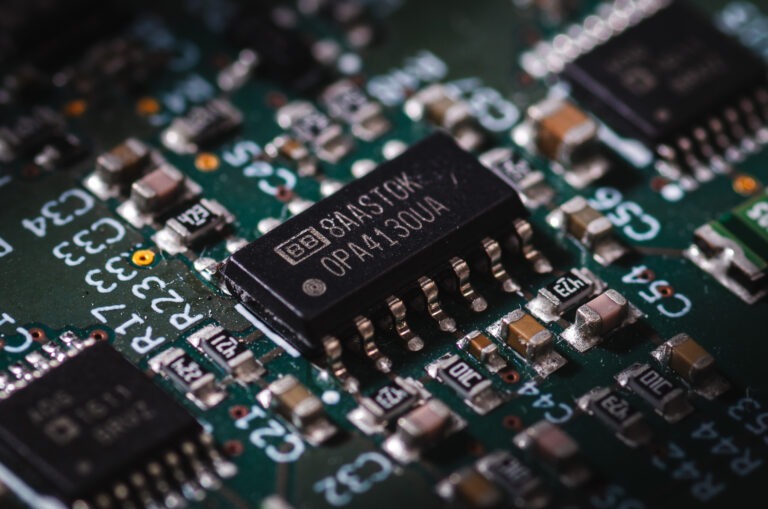Tronel’s 2024 Embedded Trends Outlook
27 January 2024
27 January 2024
At the beginning of last year, Tronel published a blog exploring our predictions for embedded systems in 2023. We are proud to have successfully identified several trends that had a significant influence on the embedded systems world and the IT sector as a whole. So, we have decided to make this an annual tradition.
Below, you will find 5 top trends selected by Tronel’s experts as the most notable for the upcoming year. Where are embedded systems headed? What should we be watching for? What kind of innovations to expect? Let’s find out!
When dictionary publisher Collins announced “AI” as the most notable word of 2023 it came as no surprise. Since ChatGPT and other AI-based chatbots opened for public use in late 2022 and early 2023 the global IT society has been on fire with favorable and alarming voices mixed in one global chatter. AI has been a buzzword of 2023 if not of the decade.

As time passed, with a better understanding of what AI can and cannot do, came the realization that our thinking about Artificial Intelligence must change. We are no longer working with technology that can check the weather and tell jokes. Not even with one that might come up with song lyrics or write a simple short story. Solutions like Intelligent Applications, Generative AI, or AI-driven development are now at our fingertips. Questions about AI data security or AI-related ethical dilemmas are no longer problems for future generations to solve. We must deal with them here and now.
The embedded solutions world, like any other tech industry, cannot afford to miss out on the opportunity AI brings. As IoT and computing on the edge are gaining momentum, we might soon see AI becoming a crucial part of the embedded solutions landscape with neural networks running directly on the hardware. With AI-driven technologies data can be analyzed on the device itself and decisions made without any traffic to and from the cloud.
Maintenance and anomaly detection are fields where AI brings innovation to embedded solutions. With AI integration into the hardware, we can maintain a more accurate record of usage levels and gain a better understanding of when maintenance-related actions should be performed. AI can also monitor processes running on the machines, as well as data traffic, to ensure the system remains secure.
Whatever tech breakthroughs 2024 will bring, we can be sure that AI will be an integral part of them.
Historically, security and embedded solutions have not always gone hand in hand. For a long time, and we must remember that embedded solutions history started in the 60ties and gained momentum in the 90ties and early 2000s, embedded hardware was considered fairly safe. With no network connectivity and physical access being the only possibility to reach the data, security breaches were not at all that common. This changed drastically in the Internet era when data gathered by embedded data loggers or IoT devices became significantly easier to break into. At the same time more and more sensitive data is kept on the hardware and servers, with medical or other private information not being an exception.

It is not a surprise that data security has become paramount in embedded systems development. In a world that connects all the devices into one big network, and where data is one of the most valuable assets, any possible system vulnerabilities cannot be overlooked. Securing access to the device itself, encryption of data exchange, and fixing all the lingering issues coming from the legacy or no longer supported systems, are only the very basics. New threats emerge every day.
To secure the system from future, unknown threats, one approach is to minimize attack surfaces by disabling interfaces and functionalities that are not required. Still, the actual battle is in the vulnerability and risk assessment where security experts and hackers are bound together in an everlasting dance.
What’s interesting, however, is that security is no longer only the purview of the specialist. With data leaks or data encryption ransom incidents becoming mainstream news, customer awareness is growing as well. Even non-tech companies realize how important it is to maintain a secure system and be aware of possible risks. Security is becoming one of, if not the most important feature, of every embedded system.
Cloud computing, which gained traction in the early 2000s and kept growing since, has been a technological breakthrough. Moving data out of the local server rooms into the enormous data centers has lots of benefits. With lower maintenance costs, larger storage, and better processing capabilities cloud has become a standard feature of almost every IT infrastructure. Covid19 only sped up the process.

However, as the volume of data stored in the cloud rapidly increases every year, the process of moving data to and from cloud servers becomes increasingly troublesome. According to IDC, the amount of data generated by IoT devices will be close to 80 zettabytes in 2025. Additionally, with embedded and IoT solutions becoming an integral part of safety-critical industries like medical or automotive, failing to react due to congested networks, or restricted internet access, may have serious safety implications. We cannot rely on the cloud to receive, analyze, and return data in situations where a delay of a few milliseconds could mean the difference between life and death. The answer is in edge computing.
Edge is all about decentralization, data is processed as close to the source as possible. Once the sensor gathers data, it will be filtered and processed locally on the same device or a server infrastructure located in the vicinity. This allows to bypass latency and significantly reduce response time. As a result data analysis and data-driven decisions can be made almost instantly.
It may seem that while the whole IT world is still moving in the direction of the cloud, edge computing is the opposite trend. This however is not the case, edge is not replacing the cloud. It simply allows for some of the processes to be run locally and for data to be pre-processed before being transmitted to centralized data centers.
According to Gartner estimates computing on the edge will take embedded solutions world by storm. By 2025, 75% of data will be processed on the edge, compared to only 10% in 2018. It is a trend worth keeping an eye on.
For almost 40 years C and C++ were ruling embedded system development. Used often in low-level programming C/C++ is an extremely popular language, that is praised for its reliability, performance, and allowing advanced hardware control. It is also one of the so-called “bare metal” languages – a programming language that can run directly on the hardware without any operating system. To give you another example – Assembly, one of the oldest programming languages, which used to be extremely popular with embedded projects, but is slowly fading away, is also a bare metal language. And so is Rust.
Rust might be the next big language taking over embedded development. Its strong suits are built-in memory safety features and high-performance capabilities. Rust allows developers to control low-level functions of the hardware while using a readable and simple to maintain syntax. Rust’s popularity seems to be growing fast, with the language being used in many notable projects, one of which involves incorporating Rust into the Linux kernel.

Rust isn’t the only alternative to C/C++ that is gaining traction. MicroPython, an implementation of Python 3 language optimized for hardware with limited memory and computing capabilities, is another runner-up. Python, according to IEEE the most popular programming language in the world, gained enormous popularity due to its simple syntax, flexibility, and versatility. MicroPython allows developers to benefit from Python features while being optimized to work with microcontrollers.
Finally, Go, a programming language introduced by Google is also becoming popular in the world of embedded systems. Go is simple, concurrent, and has built-in memory safety features. Its disadvantages however are bigger size compared to C and lack of control over memory allocation. A few frameworks are aiming to mitigate these issues and make Go more embedded development friendly. One notable example is TinyGo, which provides higher efficiency and performance as well as allows manual memory management.
With a few C/C++ competitors on the rise, embedded development might become multilingual very soon. Maybe even in 2024.
Sustainability has been a huge topic in recent years all around the world. The thought of going green and finding ways to improve their environmental footprint is on the minds of many.
Embedded industry is in an exceptional position to help the world move into a more sustainable future. Analyzing data gathered by embedded and IoT devices allows companies to better understand their internal processes and helps with optimization. This results in energy-efficient processes and significantly reduced waste.
Environmental monitoring allows not only to observe the state of the air, soil, and water. It also helps with smart farming where data-driven decisions lead to better efficiency and healthier crops. Monitoring of natural phenomena enables disaster prediction and allows communities to trigger tornado or earthquake alerts far in advance.
The path to a sustainable future for embedded solutions lies not only in supporting other industries. Sustainable hardware and software allow embedded projects to minimize environmental impact and keep balance in the green. For hardware this not only means environment-friendly production, deployment, and recycling. It’s also about reusable, bio-degradable materials. Sustainable software must be energy-efficient and optimized to use a minimal amount of processing power. Keeping sustainability in mind while designing and coding is one of the keys to a better future for everyone.
It is fascinating to observe the embedded systems sector year after year. 2023 brought groundbreaking innovations, with the AI revolution being a game changer for many industries, embedded solutions included. It seems that we can expect 2024 to be as, or even more interesting.
In the fast-changing world keeping up with the trends and emerging new technologies is simply a must. Get in touch with our experts who will be happy to advise you on the embedded technologies available to your organization.
If you want to learn about the most recent trends in embedded systems, check out our latest article.
By Dorota Gdanska

